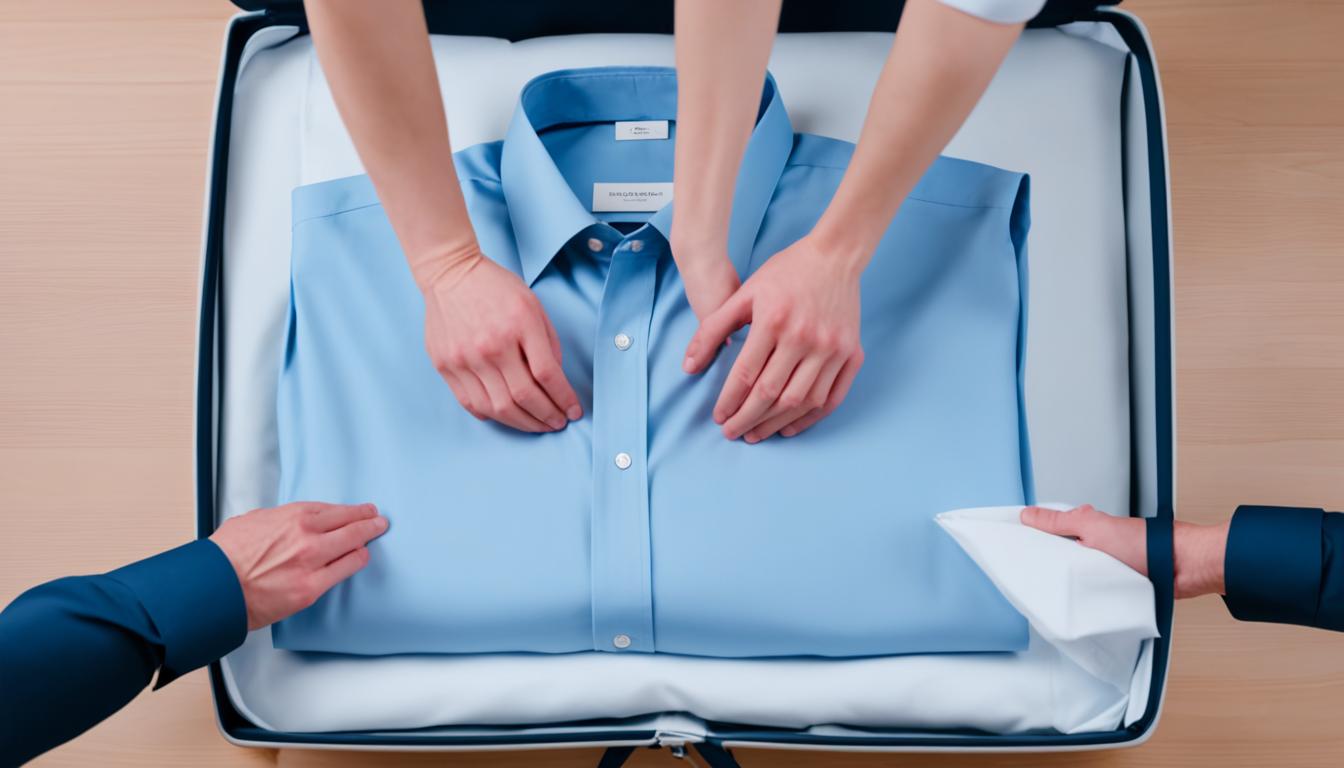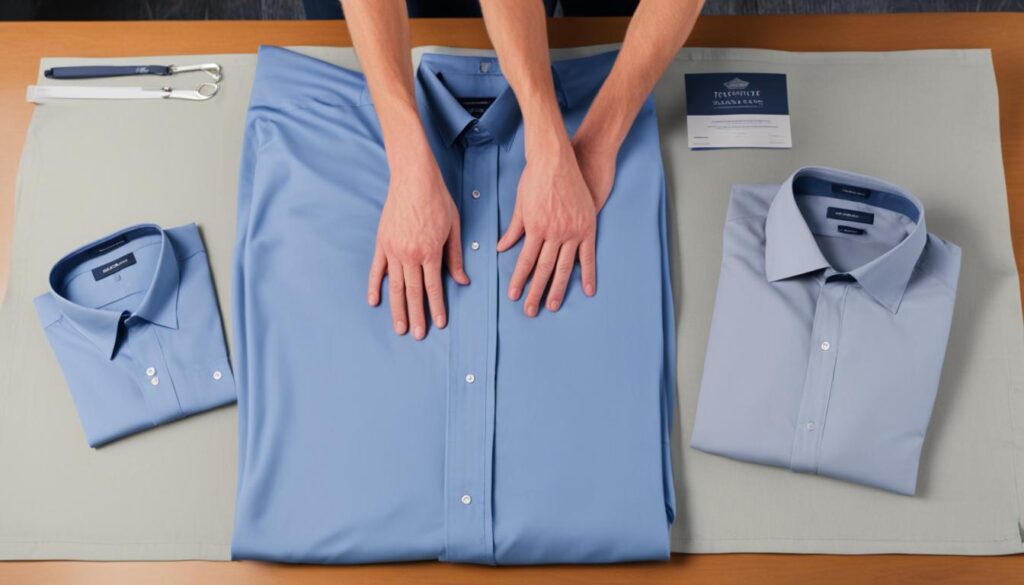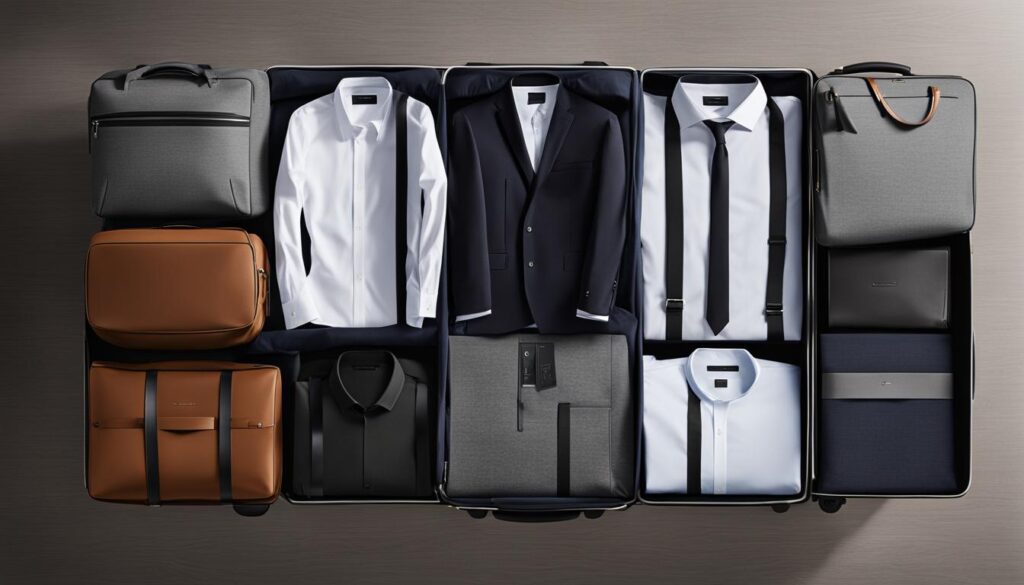
Whether you’re embarking on a high-stakes business trip or a care-free summer getaway, mastering the art of efficient shirt folding for travel is crucial. This article will guide you through various techniques and methods to fold your shirts in a way that saves space and keeps them wrinkle-free.
Key Takeaways:
- Learn how to fold your shirts efficiently to save space and keep them wrinkle-free during travel.
- Explore different shirt folding techniques, such as folding, rolling, bundling, and vacuum packing, to find the method that suits you best.
- Consider the pros and cons of each method to make an informed decision based on your travel needs.
- Choose the right luggage, like Carl Friedrik hard-side suitcases, and utilize wrinkle-removal techniques to optimize your packing.
- Alternative methods, such as steamy bathrooms, blow dryers, hair straighteners, or steaming with hot tea, can help remove wrinkles from clothes without an iron.
Shirt Packing Techniques
When it comes to packing shirts for travel, there are four main methods to consider: folding, rolling, bundling, and vacuum packing. Each method has its own advantages and drawbacks, and the choice ultimately depends on personal preference and the type of shirts you are packing.
Folding
Folding is the most common and straightforward method for packing shirts. It involves neatly folding your shirts to minimize wrinkles and maximize space. This method is ideal for dress shirts and formal attire, as it keeps them looking polished and presentable. However, folding does not save as much space as other packing techniques.
Rolling
Rolling shirts is a popular technique for saving space in your suitcase. By rolling your shirts tightly from the bottom up, you can create compact rolls that can be easily stacked. Rolling works well for casual clothing and is especially effective for packing t-shirts and other soft fabrics. Keep in mind that rolling may not prevent all wrinkles, especially with delicate fabrics.
Bundling
Bundling involves wrapping clothes around a central item, such as socks or underwear, to create a compact bundle. This method is useful for packing delicate clothes and minimizing creases in dress shirts. By wrapping your shirts around other items, you can protect them from wrinkles and optimize space in your suitcase. However, bundling can be more challenging to master and requires careful folding and arranging.
Vacuum Packing
Vacuum packing is a space-saving packing method that involves using a vacuum-sealing bag or device to remove excess air from your clothes. By removing the air, you can compress your clothes and create more space in your suitcase. This method is particularly beneficial for bulky or irregular-sized clothes. However, vacuum packing requires additional equipment and may not be suitable for all travel situations.
When choosing a packing technique for your shirts, consider the type of shirts you are packing, the amount of space you have in your suitcase, and your personal preferences. A combination of these techniques can also be used to optimize space and minimize wrinkles. Experiment with different methods to find the one that works best for you.
Next, we will dive into detailed step-by-step tutorials for each packing technique, providing guidance on how to fold, roll, bundle, and vacuum pack your shirts for travel. We will also explore the pros and cons of each method to help you make an informed decision. Stay tuned!
Folding Shirts for Travel
Folding is the most common and straightforward method for packing shirts. To fold a dress shirt for travel, follow these step-by-step instructions:
- Start by buttoning up the dress shirt and laying it flat on a clean surface.
- Next, fold the sleeves diagonally towards the center of the shirt.
- Then, fold the sleeves back up, aligning them with the folded edge of the shirt.
- Now, fold the length of the shirt in half or thirds, depending on your preference and the size of your suitcase.
This folding technique minimizes wrinkles and keeps your shirts neatly organized. While it may not save as much space as other packing methods, it ensures that your shirts remain wrinkle-free during your travels.
Pro Tip: If you’re packing multiple shirts, consider placing a layer of tissue paper or thin fabric between each folded shirt to further prevent wrinkles.
Rolling Shirts for Travel
When it comes to saving space in your suitcase, rolling shirts is a popular and effective technique. This space-saving shirt rolling method allows you to maximize the capacity of your luggage while keeping your shirts relatively wrinkle-free. Follow this rolling shirts tutorial to master the art of efficient and compact clothes packing.
To roll your shirts for packing, start by laying the shirt flat on a clean surface. Smooth out any wrinkles to ensure a neat roll. Begin rolling tightly from the bottom up, making sure to keep the sleeves tucked in as you go. The goal is to create a tight, cylindrical shape.
Once you have rolled the shirt completely, tuck the rolled portion into itself. This helps to secure the roll and prevent it from unraveling. Remember to roll your shirts tightly to save as much space as possible.
This rolling method works especially well for stacking similar-sized shirts, such as casual t-shirts or button-down shirts. It allows for easy organization and retrieval of shirts when you need them. However, keep in mind that rolling may create more wrinkles compared to folding, especially with delicate fabrics.
Pro Tip: To prevent excessive wrinkling, consider layering a thin garment, such as a t-shirt or underwear, between each rolled shirt.
Now that you know how to roll clothes for packing, it’s time to put this space-saving technique into practice. Experiment with rolling shirts of different fabrics and sizes to find a method that works best for you and your travel needs.
Advantages of Rolling Shirts:
- Saves space in your suitcase
- Allows for easy organization and retrieval
- Ideal for stacking similar-sized shirts
Disadvantages of Rolling Shirts:
- May create more wrinkles than folding, especially with delicate fabrics
Bundling Shirts for Travel
When it comes to efficient shirt packing for travel, the bundling technique is a game-changer. Bundling involves wrapping clothes around a central item, such as socks or underwear, to create a compact and organized bundle. This method is particularly effective for delicate clothes packing, including dress shirts, as it minimizes creases and saves valuable suitcase space.
To bundle your shirts successfully, follow these steps:
- Start with a central item, like a pair of socks.
- Lay your shirt flat on a surface, with the back facing up.
- Place the central item in the center of the shirt.
- Wrap the sleeves and other parts of the shirt around the central item, making sure to tuck in any loose ends.
- Continue wrapping until you have a compact bundle.
- Secure the bundle with rubber bands or packing straps to keep everything in place.
The key to successful bundling is careful folding and arranging. Take your time to ensure that each shirt is neatly wrapped around the central item, with minimal overlapping or bunching. This will help prevent creases and wrinkles in your dress shirts, keeping them looking sharp and ready to wear.
“Bundling clothes for travel is an art in itself. It allows you to pack delicate items like dress shirts without worrying about excessive creasing. Take the time to master this technique, and you’ll be amazed at how much space you can save in your suitcase.”
Tips for Bundling Shirts:
- Choose a central item that is not too bulky to ensure a compact bundle.
- Use rubber bands or packing straps to secure the bundle and prevent unwrapping in transit.
- Place the bundles strategically in your suitcase to make the most of the available space.
- Consider using compression packing cubes or bags to further minimize the size of your bundles.
By utilizing the bundling technique, you can confidently pack your delicate dress shirts without worrying about excessive creasing or wasting valuable suitcase space.

| Advantages | Drawbacks |
|---|---|
| Minimizes creases in dress shirts | May be challenging to master |
| Saves space in the suitcase | Requires careful folding and arranging |
| Works well for delicate clothes packing |
Vacuum Packing Shirts for Travel
Vacuum packing is a space-saving packing method that allows you to maximize the available space in your suitcase. By using a vacuum-sealing bag or device, you can remove excess air from your clothes, including shirts, and compress them into a smaller size. This method is particularly beneficial for irregular-shaped clothes and can help you fit more items in your luggage.
To vacuum pack your shirts for travel, follow these steps:
- Fold your shirt neatly, ensuring that all buttons are secured.
- Place the folded shirt inside a vacuum-sealing bag.
- Seal the bag tightly, leaving a small opening for the vacuum nozzle.
- Attach the vacuum nozzle to the opening of the bag and turn on the vacuum.
- Allow the vacuum to remove the air from the bag, causing the shirt to compress tightly.
- Once the bag is fully compressed, remove the vacuum nozzle and seal the opening completely.
By vacuum-sealing your shirts, you can significantly reduce their size and create extra space in your suitcase. This method is especially useful when packing bulky or irregularly shaped shirts, such as sweaters or blouses with embellishments. However, it’s important to note that vacuum packing requires additional equipment, such as a vacuum-sealing bag or device.
Pros and Cons of Folding Shirts for Travel
Folding shirts for travel offers several advantages that make it a popular choice for many travelers. First and foremost, folding helps reduce wrinkles in your shirts, ensuring that you arrive at your destination looking sharp and presentable. It also requires minimal effort and is easy to execute, making it an accessible option for everyone.
However, folding shirts for travel has its drawbacks as well. One of the main disadvantages is that it does not save much space in your suitcase. Folding shirts in a traditional manner can take up a significant amount of room, limiting the number of garments you can pack. Additionally, folding along the same fold lines repeatedly can create creases on the fabric, which may require extra attention to remove later.
Another potential drawback of folding shirts is that it can make it more challenging to find specific shirts in your suitcase. When shirts are neatly folded and stacked, you may need to rummage through them to find the one you want to wear, especially if you are in a rush.
Ultimately, when deciding whether to fold your shirts for travel, consider the pros and cons. If wrinkle reduction and ease of execution are your top priorities, folding may be the right choice for you. However, if saving space and minimizing creases are more important, you may want to explore alternative packing methods such as rolling or bundling.
Keep in mind that there is no one-size-fits-all approach, and what works best for one traveler may not work for another. Experiment with different techniques to find the one that suits your needs and preferences. Remember, the goal is to optimize your packing and ensure that your shirts arrive at your destination in the best possible condition.
Pros and Cons of Rolling Shirts for Travel
Rolling shirts offers the advantage of saving a significant amount of space in your suitcase. It is also easy to execute and works well for various types of garments. However, rolling may leave more wrinkles compared to folding, especially with delicate fabrics. It may not be suitable for thick garments.
Folding vs. Rolling: A Wrinkle-Free Dilemma
“Rolling shirts for travel is a game-changer. It significantly reduces the amount of space your shirts occupy, allowing you to pack more efficiently. Plus, it’s so simple to do – just lay the shirt flat, roll it up tightly, and you’re good to go. It’s perfect for casual shirts, t-shirts, and lightweight fabrics. The space-saving benefits make rolling an excellent choice, especially when you have limited luggage space” – Travel Guru, Samantha Peterson.
While rolling shirts is generally advantageous, there are a few drawbacks to consider. Delicate fabrics such as silk or thin linen may be prone to more wrinkles when rolled. The tighter the roll, the more pressure is applied to the fabric, increasing the likelihood of creases. Additionally, if you’re packing thick garments like heavy sweaters or woolen shirts, rolling may not be the best option, as it can create bulkiness.
Pros of Rolling Shirts for Travel:
- Saves significant space in your suitcase
- Easy execution, suitable for various garments
Cons of Rolling Shirts for Travel:
- May result in more wrinkles, especially with delicate fabrics
- Not suitable for thick garments, can create bulkiness
Consider these pros and cons when deciding whether to roll your shirts for travel. Assess the type of fabric and thickness of your garments to determine if rolling is the best method for your specific needs.
| Pros | Cons |
|---|---|
| Saves significant space | May result in more wrinkles with delicate fabrics |
| Easy execution | Not suitable for thick garments, can create bulkiness |
As shown in the table above, the pros of rolling shirts for travel include space-saving benefits and easy execution. However, there are cons to consider, such as a potential increase in wrinkles with delicate fabrics and unsuitability for thick garments.
Expert Tip:
“If you’re rolling shirts for travel, consider using tissue paper or garment bags to minimize friction between garments and reduce wrinkles. This extra layer of protection can help keep your shirts looking fresh when you arrive at your destination.” – Packing Specialist, Lisa Brooks.
Carl Friedrik Luggage for Wrinkle-Free Travel
Choosing the right luggage is essential when it comes to enhancing your shirt-folding efforts for wrinkle-free travel. In this section, we’ll explore the premium options offered by Carl Friedrik that can revolutionize your packing experience.
If you prioritize protection for your clothes during travel, Carl Friedrik’s hard-side suitcases with a tough polycarbonate shell are the perfect choice. These suitcases are designed to withstand the rigors of travel, ensuring your shirts stay wrinkle-free throughout your journey.
To further optimize your packing and minimize wrinkles, Carl Friedrik suitcases come equipped with a removable compression pad and flexible compression straps. These accessories help compress your load, ensuring your dress shirts stay neatly folded and crease-free.
Here is a breakdown of the advantages offered by Carl Friedrik luggage:
| Advantages of Carl Friedrik Luggage |
|---|
| Tough polycarbonate shell for maximum protection |
| Removable compression pad for efficient packing |
| Flexible compression straps for wrinkle-free dress shirts |
With Carl Friedrik luggage, you can rest assured that your clothes, especially your dress shirts, will arrive at your destination in impeccable condition. Say goodbye to unsightly wrinkles and hello to effortless, wrinkle-free travel.
Image:

How to Remove Wrinkles from Clothes Without an Iron
Even with careful folding or rolling, clothes may still develop wrinkles during travel. If you don’t have access to an iron, there are alternative methods to remove wrinkles.
Hanging a wrinkled shirt in a steamy bathroom can help relax the fabric. The steam will loosen the wrinkles, allowing the shirt to regain its smooth appearance. This method is particularly effective for delicate fabrics that may be damaged by direct heat.
Using a blow dryer on high heat or a hair straightener can also be effective in removing wrinkles. Simply hold the blow dryer close to the fabric, or glide the hair straightener over the wrinkled areas. Be sure to keep the blow dryer or hair straightener moving to avoid overheating or burning the fabric.
QUOTE:
For our British readers, another technique to consider is steaming your clothes with the steam from a cup of hot tea. Hang the wrinkled shirt near the cup of steaming tea and let the steam work its magic. Just be careful not to spill any tea on your clothes!
Using these non-iron methods, you can easily de-crinkle your clothes and keep them looking presentable without the need for an iron. Remember to choose the method that suits your fabric and travel conditions best.
Comparison of Non-Iron Methods
| Method | Advantages | Disadvantages |
|---|---|---|
| Hanging in a Steamy Bathroom | – Safe for delicate fabrics – Requires no additional tools – Can be combined with other activities |
– Takes time for the wrinkles to loosen – Not suitable for thick fabrics |
| Blow Dryer | – Quick and efficient – Suitable for a wide range of fabrics |
– Requires access to electricity – May damage delicate fabrics with high heat |
| Hair Straightener | – Effective for targeting specific wrinkles – Suitable for small areas |
– Requires access to electricity – May cause damage or scorching if not used carefully |
| Steaming with Tea | – Can be done easily using common household items – Gives a unique touch with the aroma of tea |
– Limited to British readers – Requires caution to avoid spills |
Conclusion
Mastering the art of efficient shirt folding for travel is essential for any traveler. Whether you choose to fold, roll, bundle, or vacuum pack your shirts, the goal is to save space and keep them wrinkle-free.
Consider the pros and cons of each method and choose the one that suits your needs best. Folding shirts is the most straightforward method and reduces wrinkles. Rolling shirts is great for saving space, but may cause more wrinkles, especially with delicate fabrics. Bundling is ideal for delicate clothes and minimizes creases, but may require careful folding. Vacuum packing is the most space-saving method, but can be time-consuming and requires additional equipment.
Remember to choose the right luggage to enhance your shirt-folding efforts. Brands like Carl Friedrik offer durable hard-side suitcases with compression features to keep dress shirts wrinkle-free. And if wrinkles do appear, try alternative methods like steaming in a steamy bathroom or using a blow dryer or hair straightener to remove them. With these space-saving packing tips and wrinkle-free travel techniques, you’ll be well-prepared for a smooth and stylish journey. Safe travels!





